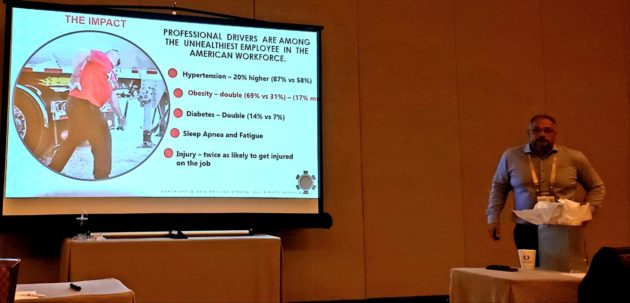The time is now to focus on driver health
LAS VEGAS, Nev. – Stephen Kane believes the trucking industry has done a great job using technology to improve safety, but says it’s now time to focus on the health and well-being of the men and women behind the wheel.
Kane, speaking during Omnitracs Outlook 2020 in Las Vegas, Nev., yesterday, is the president of Rolling Strong, an organization that aims to improve driver health by educating about fitness, nutrition, and building wellness programs tailored to individual drivers.
The program is available to U.S., Canadian, and Mexican drivers, and Kane is hoping to expand Rolling Strong in Canada to offer more of its services to drivers north of the border.
And help is certainly needed.
As Kane points out, truck driving is the unhealthiest, most unfit profession in the U.S., which is likely mirrored in Canada.
“That’s statistically a fact,” said Kane. “Seventeen percent of drivers are morbidly obese. I hate it, I struggle with it.”
The reason Kane struggles with driver health is because he used to be one. Kane was a professional driver for 10 years, and he eventually saw the impact that had on his health.
A USA certified boxing coach, triathlete, and overall fitness junkie, Kane had his share of health problems over the years, including a bout with cancer.
Receiving support from his fellow driving community when battling the disease, Kane said the experience has only enhanced his desire to help his “brothers” live a healthier and more active lifestyle.
One of the obvious factors that contributes to poor driver health is the sedentary nature of the job. Drivers sit anywhere from eight to 11 hours a day, and even when off-duty are often in their sleepers, sitting at a truck stop, on the phone with their family, or watching a movie.
Kane said the average driver exercises 8% of the day – walking, running, lifting, etc. – while the rest of the population averages around 50%.
Lack of sleep is another major cause of deteriorated health. Truck drivers tend to get only around five to six hours of sleep each night. In the U.S., with its 14-hour on-duty rule, drivers have 10 hours of off-duty time. During that time, they eat, talk to family, shower, use the bathroom, watch a movie, read a book, or any other activity they enjoy during their downtime, all leading to less time for sleep.
Stress also has an impact on driver health. Fighting traffic, inclement weather, and mountain passes to get their load to the receiver on time all contribute.
Some of the most common health issues drivers face include hypertension (20% higher that rest of population), diabetes (double the risk of others), fatigue, over-weight or obesity, and being twice as likely to be injured on the job than other professions.

The industry has done some things to help with driver health, including HOS regulations (which in the U.S. are being reviewed with the hopes of improvement), creating committees to research driver health, and performing medical exams to ensure a driver is fit to be behind the wheel.
Of the 3.5 million commercial drivers in the U.S., the Department of Transportation (DOT) disqualified 58,424 in 2017 based on poor health. Millions more have been issued two-year and short-term cards allowing them to continue driving, but will need to return for follow-up exams to monitor their health.
Kane is urging the industry to do more to improve driver health, suggesting reworked HOS regulations that would allow for more time for sleep, increasing nutritious food options at truck stops, educating drivers, and conducting more up-to-date research.
Carriers would benefit from a fitter driver pool, said Kane, with less absenteeism, better productivity, less turnover, lower health premiums, and reduced accidents and injuries.
Kane says drivers can do several little things to improve their health, such as eating smaller meals, using an app to track their nutrition, stretching, not drinking caffeine during their final miles, and drinking plenty of water – half their body weight in ounces.
Have your say
This is a moderated forum. Comments will no longer be published unless they are accompanied by a first and last name and a verifiable email address. (Today's Trucking will not publish or share the email address.) Profane language and content deemed to be libelous, racist, or threatening in nature will not be published under any circumstances.
Nice thought.
Should be implemented by the organizations, and also followed by the drivers, some of whom think it is a waste of time.
As a safety manager, I felt it was my duty to educate my drivers on health and fitness. I put out bulletins and made myself available to discuss positive changes they could make while on the road. Simple things like walking around the truck twice (instead of only once) when doing a road check…or when at shippers waiting for a load.
Great article, Derek. This is exactly the kind of thing that is needed now. Should have been the focus years ago. But better late than never for sure. Focusing on the core driving force and their needs will be the difference between having drivers and not, moving forward.
Many current trucking companies and insurance companies do not seem to care about truck drivers. The current model needs some big changes as e-logs are making many health problems worse.
Nice thought. A little late for a lot of us, though.